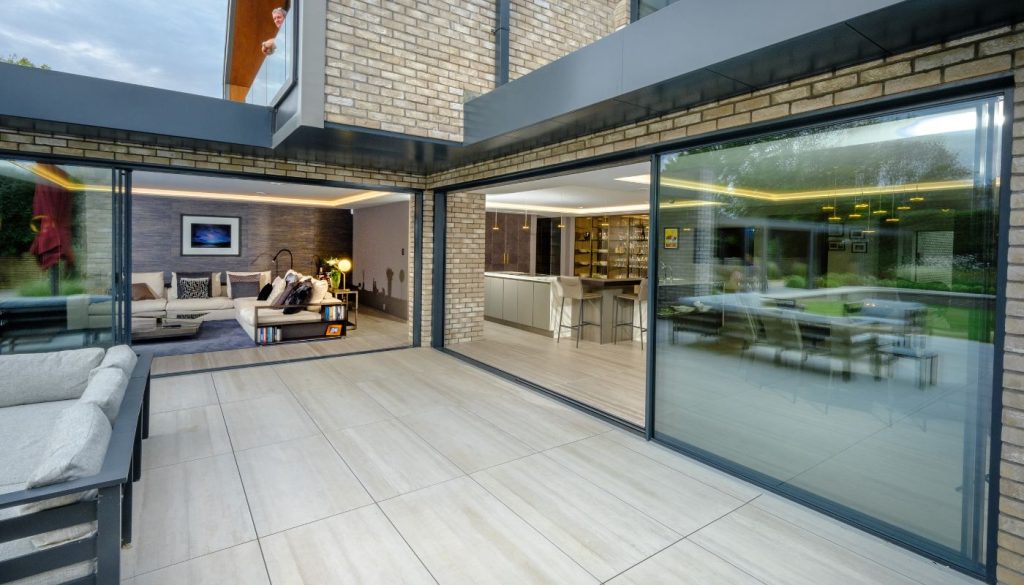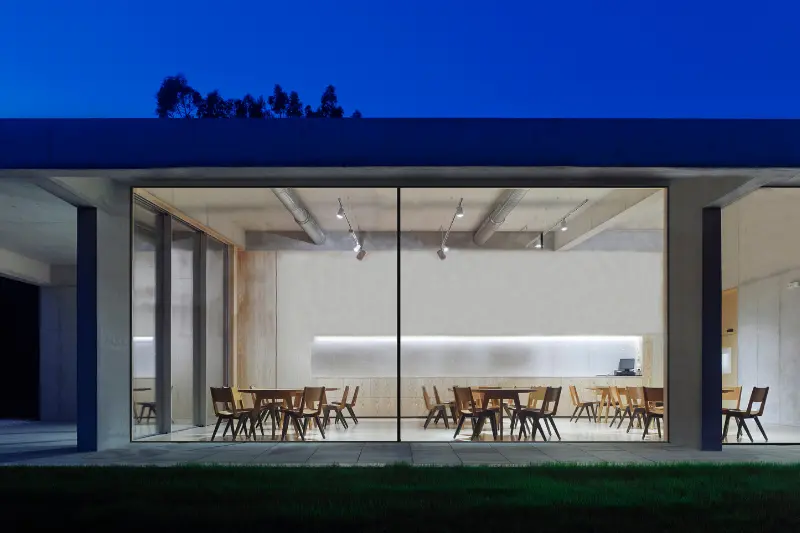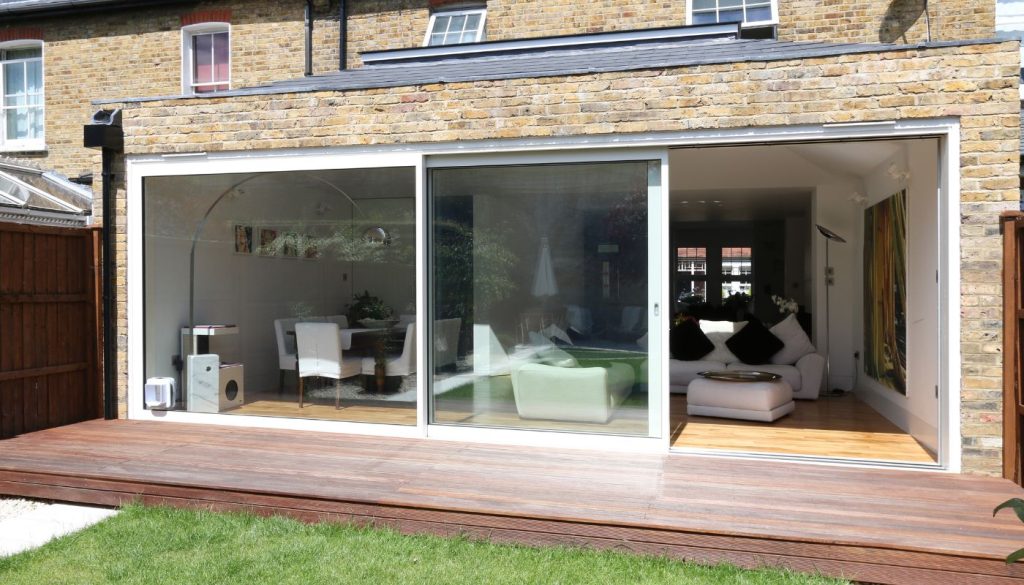TECHNICAL ADVICE
The Ultimate Guide to Sliding Doors
Sliding doors open up spaces more than any other system. They offer the largest uninterrupted views, maximise natural light, and their clean, contemporary look goes well with any project. Practical and easy to operate, sliding doors glide along a track rather than swinging open, so they’re ideal for tighter spaces.
This comprehensive guide walks you through all you need to know about them – types, materials, glazing options, thermal performance, installation considerations, cost factors and more – so you can select the perfect system for your project.

Types of Sliding Doors
Frameless Sliding Doors:
Frameless options adhere to your most minimal design visions, using structural glass and concealed tracks. Perfect for projects emphasising a “barely there” aesthetic.
Slim-Framed Sliding Doors:
Slim-framed doors support large glass panes with minimal aluminium profiles, often as narrow as 20–25mm. Many top systems incorporate thermally broken aluminium frames for superior insulation. For further tips on keeping frames slim and cost-effective, see our Cost Effective Solutions for Slim Framed Glazing.
Pocket Sliding Doors:
Pocket doors slide into a concealed cavity within the wall. When fully open, the panels disappear from sight, creating a completely unobstructed opening. They’re popular for projects prioritising a continuous visual flow.
Oversized Sliding Doors:
Sieger Systems can accommodate exceptionally large panes – up to 4m wide or tall per panel – thanks to robust aluminium frames and high-spec glazing. Oversized doors of this kind are essentially dramatic floor-to-ceiling glass walls, often used in luxury residential projects. If you’re considering large-format designs, check out the Advantages of Oversized Sliding Glass Doors.
Corner Sliding Doors:
Corner configurations remove any need for a structural post at the meeting point, allowing two sliding door sets to meet at a right angle. When opened, the corner seemingly vanishes, creating a breathtaking “floating” roof effect that blurs the line between indoor and outdoor spaces from every angle.
Key Features to Consider
Material Choices:
Aluminium is the go-to material for sliding door frames. It’s strong, lightweight and low-maintenance, enabling slimmer profiles and larger panes than timber or uPVC. While timber may offer traditional charm and uPVC budget appeal, aluminium is usually a better investment. It provides durability, weather resistance, and energy efficiency that stand the test of time.
Frame Thickness and Sightlines:
Ultra-slim frames minimise visual interruption. High-quality systems maintain structural integrity without the need for bulky profiles. It’s the kind of refined look that characterises modern architecture. By cleaning up all of these visible sightlines (vertical interlocks, head and base tracks, side frames), you can achieve a cohesive minimalistic aesthetic.
Glass Options:
- Low-Iron Glass: Enhances clarity, reducing the greenish tint standard glass can have. Perfect for extra-clear views and true-to-life colours.
- Triple Glazing: Boosts insulation, achieving exceptionally low U-values, ideal for energy-efficient builds.
- Coatings (Low-E, Solar Control): Low-emissivity coatings reflect heat back into the home, while solar control coatings help prevent overheating in sun-exposed elevations.
Threshold Design:
Flush thresholds create seamless transitions between indoors and outdoors. Preventing tripping hazards and easing accessibility is great, but imagine the comfort of stepping across barefoot! Best-in-class systems integrate concealed drainage channels, ensuring water runoff without compromising aesthetics.
Locking Mechanisms and Security Ratings:
For external doors, consider models tested to PAS 24 or similar security standards. Multiple locking points, laminated glass, and robust key cylinders enhance security and peace of mind.
Thermal Performance and Efficiency
Energy efficiency is crucial, particularly in climates with temperature extremes or in homes championing high sustainability standards. Sliding doors can be engineered to offer excellent insulation and airtightness.
Thermal Breaks:
Aluminium frames often include polyamide thermal breaks, preventing conductive heat loss through the metal. For an in-depth look at why that matters, see Thermal Bridging and Thermal Breaks Explained.
Understanding U-Values:
-
Ug:
Thermal performance of the glass itself.
-
Uf:
Thermal performance of the frame.
-
Uw:
Overall thermal performance of the entire door system.
Aim for low Uw values for greater comfort and reduced energy bills.
Coatings and Gas Fills:
Double or triple glazed units [https://www.siegersystems.co.uk/products/triple-glazed-sliding-glass-doors/ ] filled with argon (or similar inert gases) and coated with low-e films also help maintain comfortable interiors. Solar control coatings can prevent overheating in south-facing rooms, reducing the need for air conditioning.
Exposed or Marine Environments:
If your project is near the coast or in an exposed location, you should consider marine-grade finishes on aluminium and low-maintenance glass coatings to guard against salt corrosion, higher wind loads and driving rain.

Design Flexibility
When you work with the experts, sliding doors offer considerable freedom to tailor the system to your project’s needs:
Finishes and Colours:
Aluminium frames can be powder coated in any RAL colour to match your design scheme. Specialist finishes mimic timber or steel, blending modern performance with traditional or industrial aesthetics. You’re in good hands if you love the look of steel, but want to avoid its price tag. We have a range of steel-look systems, helping you to keep the functional benefits of aluminium. Would you like to see these in person? Click here to visit our showroom!
Configurations:
Multi-track options allow multiple sliding panels to stack behind each other. Bi-parting doors can open from the centre, while pocket doors vanish entirely into walls. Corner configurations and oversized panels further extend design possibilities.
Architectural Styles:
Sliding doors complement a range of aesthetics – from minimalist modernist homes to period properties that benefit from steel-look glazing bars. They can also enhance biophilic design principles by merging interiors with natural surroundings, increasing daylight and framing epic views.
Installation and Maintenance
Pre-Installation Considerations:
Accurate measurements, proper structural support and provisions for drainage are essential. If integrating a pocket door, ensure walls can accommodate the cavity. Consider flush thresholds and confirm floor finishes to achieve a seamless look.
Maintenance for Longevity:
High-quality aluminium sliding doors require minimal upkeep. Clean the frames and glass periodically with mild soapy water and check that tracks are free of debris. Inspect seals, gaskets and locking mechanisms annually to ensure ongoing smooth operation and energy efficiency. With proper care, aluminium systems can last upward of 45 years.
Harsh Environments:
As mentioned, for coastal or poolside installations, pre-anodised frames combined with marine-grade powder coatings enhance resistance to corrosion. Low-maintenance glazing options simplify cleaning, as rain naturally washes away dirt on specially coated surfaces.
Applications of Sliding Doors
Residential:
Patio doors leading to a garden, balcony doors overlooking a cityscape, or even internal sliding doors that divide living areas while preserving light – all look beautiful, bring joy to your daily routine, and boost the value of your property.
Commercial:
Offices, hotels and restaurants utilise sliding doors for meeting rooms, terraces and storefronts, creating flexible, ambient spaces. Large expanses of glass in commercial environments help connect interiors with outdoor courtyards or inspiring urban views. If you have access to a picturesque spectacle, capture it with sliding doors.

Cost Considerations
Factors Influencing Price:
- Material choice (aluminium vs. timber vs. uPVC)
- Glazing specification (double, triple, low-iron, laminated)
- Oversized panes or special configurations
- Specialist finishes and automation features
Price Ranges:
For a standard, slim-framed aluminium sliding door, expect approximately £750/m² as a guide. More advanced systems with larger panes, triple glazing, or automated operation can increase costs.
Long-Term Value:
Higher initial investment in quality materials, thermal breaks and advanced glazing pays off over time, through reduced energy bills, lower maintenance costs and lasting durability.
For more detailed insights, see A price guide for sliding doors.
Emerging Trends and Innovations
Automation and Smart Technology:
Motorised sliding doors can be operated at the touch of a button or integrated into smart home systems. Sensors, remote controls and app-based interfaces offer convenience and accessibility.
Sustainable Materials:
Recycled aluminium and eco-friendly coatings are tried and trusted components of sustainable construction. Advancements in glazing technology continue to push performance boundaries, enabling better insulation and reduced environmental impact.
Creative Glass Solutions:
From decorative interlayers that mimic natural textures, advanced solar control coatings, our even a sliding door with a cat flap, our latest glazing options enhance comfort, privacy and design flexibility.

Let Us Help You
Sliding doors, especially exquisite and affordable ones, are a real treat for your project. By considering factors like frame materials, glazing quality, thermal performance and installation details, you can select a beautiful, comfortable, secure and sustainable system.
Our sliding doors are custom built to meet your practical needs and design aspirations. With the right choice, your new sliding doors will become a defining feature of your space that keeps all the focus on the natural beauty of your beloved outdoor areas.
Would you like to consult us for tailored sliding door advice? Contact Us Now!
Contact Us Now!
RELATED CASE STUDIES
Case Studies

